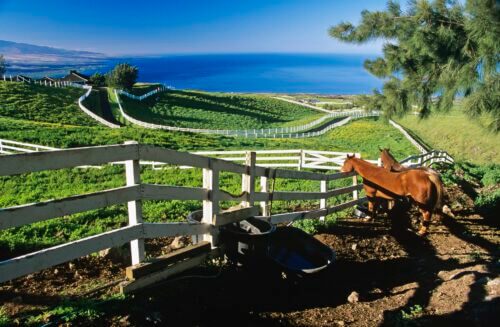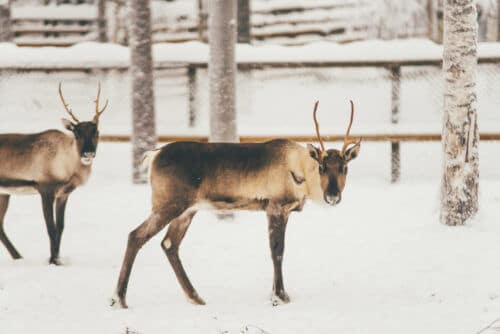Researchers became interested in the effect of fences following observations of animals in California, Kenya, China and Mongolia, when strange behaviors were observed near fences, such as deer that walk many kilometers along fences or predators that use the fence line as a main road

Fences are very common infrastructures and have a huge environmental impact in the entire world, which until recently was not measured.
According to the assessment, There are fences with a general length greater than the length of all the roads in the world,
According to the same assessment, if the definitions are deployed in one lane, they will reach the sun and back several times. Ancient and new fences are spread over every continent, in cities and open areas. There are fences everywhere and some are becoming a permanent sight, it turns out from a recent survey.
Based on the findings, the reviewers propose a road map that will change this reality and form the basis of a field that will be called "ecology of fences". With the help of collecting data from all over the world, it turned out that fences create a complicated set of environmental effects, some of them are small in size like spiders weaving their webs on fences, and others cause changes in behavior and even death of animals. The collapse of the Mara's environmental system (Mara) in Kenya is an example of one of the harmful effects of fences.
Until recently, the need to investigate the effect of definitions was not clear. As with roads, only in 1990 did scientists show that roads, which are part of human history, have a huge environmental impact, so today it is known that roads separate and destroy habitats, Allow collisions between vehicles and animals, cause air and water pollution and more.
The team of researchers became interested in the effect of fences following observations of animals in California, Kenya, China and Mongolia, when strange behaviors were observed near fences, such as deer that walk many kilometers along fences or predators that use the fence line as a main path.
Although there are publications on the behavior of animals around fences, the publications refer to certain species and not to all animals or to the overall effect of fences on the environment. Through the compilation of the publications, new and important details about the effect of definitions were clarified and discovered.
It was found that it is not always possible to define the effect of fences on the environment as negative, because the effect is complex and multifaceted so that the fence creates conditions that for some animals will be positive and for others negative. The researchers define this as "winners and losers", but even such "good fences" erected to protect a sensitive habitat or an endangered species may cause an interruption between environmental systems, for example a fence erected in Botswana to prevent the transfer of diseases from wild animals to cattle - stops the Wildebeest migration. Wounded and dead animals can be seen along the fence.
Area closure to protect one species may harm and kill other species.
It turns out that for everyone who benefits from erecting a fence, there are losers, when usually the losers are more numerous to the point of creating "dead areas" in which a narrow and impoverished environmental system is created.
Examples from around the world show the dire consequences of definitions, even if sometimes unintended. For example, the wall between Mexico and the USA separates populations of large mammals, which has caused genetic isolation and reduced populations. Even birds such as the pygmy owl were affected.
In Australia, thousands of kilometers of fences were built To prevent dingo dogs from harming farm animals, fences created a chain of environmental reactions that reached enormous proportions, and caused changes in the environmental systems throughout the continent.
The dingo is a super predator in Australia. Its absence in the natural environment is an overpopulation of prey populations, as happens with the explosion of the population of the kangaroo species, which causes a change in the composition of the vegetation in the area to the point of emptying nutrients from the soil. Now there is a completely different environment on each side of the fence.
It was found that fences affect the environment in all dimensions. And yet in many cases there is no reference to the point of being ignored. To demonstrate this, the researchers examined the western United States in an area known for large-scale open spaces but also considered the "home of the wire fence". It was found that large areas considered undisturbed by researchers are covered by a dense network of fences.
It is clear that fences are here to stay, therefore there is a need to develop a field for the study of "fence ecology". The research will consider the role of fences in the economic, political and social elements. According to the reviewers, there is evidence that the impact of definitions can be mitigated by changes in form and structure. For example, experiments were conducted in Montana and Wyoming with wildlife-friendly fences, which prevent cattle from crossing but allow antelope species to pass through them without injury. These fences fulfill the need for which they were erected with minimal damage to the natural environment and wildlife.
To mitigate the damage and at the same time save on construction costs, fences can be placed along natural ecological boundaries such as streams or topographical structures. At the same time, it is appropriate to remove old fences that have no "function" that have been defined as "ghost fences", since fences have a long-term effect even after their removal. The study showed that there are animals that continue to behave as if the fence still exists.
For example reindeer in Europe Avoid crossing areas that were fenced during the "Iron Curtain" period.
Understanding the problem, landowners and political bodies must be careful in placing permanent fences and consider erecting temporary fences.

The researchers conclude with a statement: "People should see new fences as a permanent link to the chain that surrounds the earth", and thereby prevent the construction of offensive and unnecessary fences.
We also have fences, some of which are unnecessary and others offensive: because the country is small and accordingly the reserves are sometimes tiny, there is a need for fences to separate agricultural areas, settlements, roads and other infrastructure from the reserves. For example, when it was decided to charge a fee for a visit to Nahal David and it was necessary to fence the entrance, I took advantage of the opportunity and the fence was built around large parts of the agricultural lands to prevent goats from damaging the crops, it's just a shame that today the fence is breached due to negligent maintenance.
Garbage is a risk for the animals, therefore it is necessary to fence landfills and garbage accumulations that are a source of attraction for wild animals. Broken and sometimes missing fences around the same points of attraction - create death traps, as do cattle fences, especially in the Golan, where animals get entangled. Which can be prevented by replacing the wire fence with "friendly" fences and escape hatches. In many places where settlements have "invaded" the natural areas, such as in Haifa, it is appropriate to consider appropriate fencing.
If "good fences" were defined above, it is worth noting the effect of the border fences, our western border line with Egypt can be seen in satellite images when the area is dark to the east and light to the west. On the Egyptian side there is strong grazing by herds of sheep, so the vegetation cover on our side is denser. The border with Jordan in the Arabah is a buffer that wild animals "know" not to cross because there is wild hunting on the Jordanian side. Therefore, while the Israeli steppe is rich in wild animals, the one on the Jordanian side is a wasteland, so it turns out that in certain situations the fence has an environmental advantage.
More of the topic in Hayadan:
